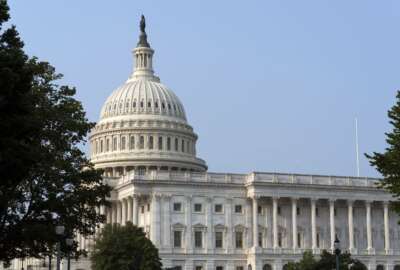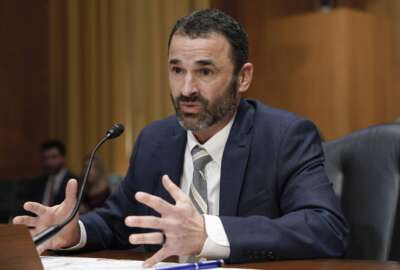Hubbard Radio Washington DC, LLC. All rights reserved. This website is not intended for users located within the European Economic Area.
On Air: Federal News Network
Trending:
CR may turn into crisis for Defense, Gates says
Continuing to operate at 2010 funding levels under a continuing resolution would be a crisis for the military, Defense Secretary Robert Gates said Monday. He ma...
wfedstaff | June 3, 2015 9:08 pm
By Jared Serbu
Reporter
Federal News Radio
Defense Secretary Robert Gates said Monday that the Pentagon’s proposed 2012 budget would preserve the military’s fighting strength, while the 2011 fiscal picture represented a looming crisis.
Gates made the comments at the unveiling of the Defense department’s 2012 budget proposal, which requests $671 billion in discretionary spending and nearly 6% less than the administration requested for 2011. Among its many provisions, the blueprint outlines changes to the military healthcare system, a pay increase for servicemembers and new funding for cybersecurity.
DoD says its lower budget proposal reflects drawdowns in Iraq and Afghanistan. Besides the $553 billion the administration requested in the DoD base budget, there is an additional $118 billion request for the overseas contingency operations budget – about $41 billion less than the administration requested for fiscal year 2011.
Gates, however, made clear at the outset of Monday’s Pentagon briefing that the status of the 2012 spending proposal is less urgent than the current year’s budget. DoD, like the rest of the federal government, still doesn’t have a congressionally-approved budget for this year. Gates said continuing to operate at 2010 funding levels under a continuing resolution has created difficulties that could soon turn into a crisis.
“If forced to operate under a full-year continuing resolution, the department would only receive about $526 billion — a cut of $23 billion,” Gates said. “The damage done across our military from that reduction would be magnified as it comes halfway through the fiscal year.”
Gates said he realized that it was unlikely that Congress would approve the full amount of the President’s request for 2011. He said Monday that the department could “get by” with a lower number, but no less than $540 billion. Gates said deeper cuts would hinder the military’s ability to perform its missions.
“I’m concerned that the debate over the defense budget in recent days and weeks is becoming increasingly distant from strategic and operational reality — distant, in other words, from the real world,” he said. “In fact, suggestions to cut defense by this or that large number have largely become exercises in simple math, divorced from serious considerations of capabilities, risk, and the level of resources needed to protect this country’s security and vital interests around the world.
Robert Hale, the Defense department comptroller said the absence of an enacted budget is already impacting military operations.
“The Navy could not procure the second Virginia-class submarine as planned by January 31. They’re trying to manage the risk of work termination at the yard, but they can’t hold their breath too much longer,” he said. “We have about 50 major military construction projects that are delayed beyond the projected award dates…The Army’s instituted a temporary hiring freeze, so if a tank mechanic leaves, we can’t fill the job. All the services have directed their bases to slow contracting. That means we’re going to sign one- and two-month contracts that are inherently inefficient. The Navy is issuing permanent change of station orders with two months of notice rather than six. That preserves their funding flexibility, but it hurts our people, and it hurts military families.”
Gates also threw down the gauntlet on a proposed second engine for the F-35 Joint Strike Fighter. Though the idea has support in Congress, Gates and the president have said they view it as a waste of money. Gates made clear that his view has not changed. He has allowed money from the continuing resolution budget to continue to be spent on the program until now, but he said Monday he would seek to cut off the funding. “The president, the military services and I continue to oppose this extra engine, and when the current continuing resolution expires, I will look at all available legal options to close down this program,” Gates said. “It would be a waste of nearly $3 billion in a time of economic distress, and the money is needed for higher- priority defense efforts.”
The 2012 budget is in line with the preview Gates laid out for reporters in January when he outlined the outcome of his efficiency savings initiative. It envisions what he calls modest growth in the base budget for the next three years, followed by two years of zero real growth in 2015 and 2016. The budget includes $113 billion in procurement spending, the same figure the administration asked for in 2011, but less than the Pentagon originally intended to request for 2012. Gates said that’s mostly a result of programs that were cut as part of the efficiency initiative such as like the Marines’ expeditionary fighting vehicle and the Army’s SLAAMRAM surface-lauched missile.
Cybersecurity would see new funding under the proposed budget. It includes $2.3 billion for cyber program, including $500 million for new security research at the Defense Advanced Research Projects Agency.
It also provides for some of the only pay raises government employees are likely to see next year. The budget asks for a 1.6% pay increase for the uniformed services. Civilian DoD employees would be subject to the same pay freeze as most other federal agency employees.
Fees for TRICARE, the military’s health care system, would go up for working-age retirees, as Gates said last month. The increase would be five dollars per month for family coverage, bringing an annual premium to $520. Hale acknowledged that what DoD characterizes as a modest increase won’t produce much savings at first.
“It’s a fairly small part of the total and the next five years is about $424 million,” he said. “But it will keep growing because we are proposing indexing those fees to a health care index. So if you go out 10 or 20 years, it will have a major influence. But we wanted to start slow given the past history in this area. Several years ago, the administration made much more far-reaching proposals that were turned down, pretty much flat, by the Congress. We are hopeful that by starting slowly and modest proposals, we will get their agreement.”
The TRICARE fee increases are part of a package that the department says will trim the growth in its healthcare costs by about $8 billion over the next five years. DoD budgeted $52 billion for military health care in the 2012 budget – more than twice what it did a decade ago.
DoD’s budget outlook for the next five years is for at least $78 billion less than the Pentagon originally wanted. Hale would not comment on any deliberations between DoD and the office of management and budget in arriving at that figure, though he said Defense leaders obviously would have preferred a larger allocation.
“I think that word ‘responsible’ comes to mind, that the secretary used,” he said. “This is a country that faces some really severe economic problems, and we felt we needed to be part of a package of changes the administration is recommending. So, the secretary, in the end, I think, was fully supportive of the $78 billion.”
Hale said the cut represented about 3% of DoD’s proposed five year spending.
For complete coverage of the proposed FY 2012 budget, see Federal News Radio’s Budget Stories Resource Page.
(Copyright 2011 by FederalNewsRadio.com. All Rights Reserved.)
Copyright © 2024 Federal News Network. All rights reserved. This website is not intended for users located within the European Economic Area.




